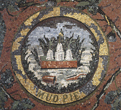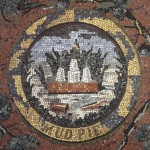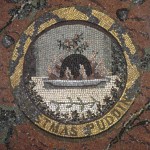Lesson 5
Mud Pie (A Test In Observation)
At which venerable London art gallery would you find a picture of a mud pie?
This innocent reference to childhood play and getting dirty, sand castles and summer holidays, along with a Christmas pudding, illustrations of football, cricket and hunting, a Covent Garden porter, a farmer washing a pig, a coal miner, a contortionist, a girl cyclist and a girl jiving. Where can we find these images of ‘modern’ life, its labours and pleasures? Where bygone celebrities are seen as allegorical personifications – Sir Winston Churchill is shown as Defiance, Dame Margot Fonteyn as Delectation and Bertrand Russell as Lucidity, Greta Garbo stars as Melpomene, the physicist Lord Rutherford is Curiosity, T. S. Eliot contemplates a kindly Loch Ness monster and Einstein’s formula for Leisure, astronomer Fred Hoyle represents Pursuit, Sixth Sense sees Edith Sitwell reading a book of poems, Augustus John is Neptune offering Alice of in Alice in Wonderland gifts from the sea for Wonder, Virginia Woolf wielding an elegant pen as Clio and the art critic Clive Bell as Bacchus, all of which are on permanent display.
This post-modern like collision of the popular culture and high art can be found in the National Gallery.
Where else?
It is not an Old Master that first greets you on entering the National Gallery but these eccentric and witty images. Set into the vestibule floor of the Portico entrance are the marble mosaics laid from 1933 to 1952 by the Russian-born artist Boris Anrep, 1 financed by Samuel Courtauld. These mosaics are a celebration of modernity and everyday life that gives little clue as to the purpose of the building you have just stepped into.
I have known and liked this mosaic pavement since the late 1960s when I was in my teens and a student at Hornsey College of Art, in those days I probably liked it for all the wrong reasons. I thought it funny, an ironic juxtaposition of low, bad art. These mosaics seemed a great folly and we all like a folly. This was kitsch in the bastion of the ‘masterpiece’, this grand Gallery of progress and civilization. Ludicrous, alongside the Old Masters and Impressionists. Were not these mosaics a bizarre project for such august a setting? This light hearted mosaic pavement is, in part, genuinely odd, even silly.
“Has anyone noticed this?
How could you have missed Mud Pie?
Look at this madness at your feet!
Am I the only one who sees this?”
I’d ask myself.
It seems no-one else looks down.
There they all are looking at the walls. Some visitors look at me, looking down, they must think I am a bit tapped!
They still look at me smiling at Mud Pie which I now consider an old friend. An old friend as with Goya’s scathing portrait of the haughty Wellington, that archetypal public school chinless wonder, which lies just a few feet away from Mud Pie. For 45 years now, a visit to the National Gallery has always included Wellington and Mud Pie and I have begun to paint my own version of Mud Pie. Mud pie is an elemental art, that has become for me an endearing insult on elitism and echos a particular English absurdity, that whimsy of Lewis Carol, Spike Milligan 2 and John Lennon.
In 1981 I visited Jock McFadyen in his basement studio when he was resident artist at the National Gallery. It was amusing to see his cuttings from magazines of big breasted middle aged women, his ‘reader’s wives’ pinned around this studio space as source material. This working class vulgarity, over the top, in your face ephemera, in this historic noble place, recalled the collision of high and low in the vestibule above us. I suggested that Jock take a look at the mosaics, he was, of course, unaware of their existence. Even people who work in the building don’t seem to notice the mad wonders that lie underfoot.
As an artist and in his understanding of modernity, Boris Anrep was no Diego Rivera nor Fernand Leger. Anrep’s labours and pleasures are far removed from Leger’s twentieth century unity of man and machine or Rivera’s epic humanist murals. Rivera, Leger and Anrep would have been contemporaries and all aspired to an optimistic and ‘Universal’ statement on social and contemporary life. However, Anrep’s work is modest and looks conservative even reactionary when compared to Rivera’s socialist histories of the Mexican people or Leger’s monumental modernist realism. However their work has the similar themes on history, human achievement, celebration of labour and leisure which pays tribute to those who laboured to build this modern world. Although for Rivera and Leger it is the ordinary working men and women whose everyday labour built modern society and not a collection of individuals or celebrities as in Anrep’s case.
Some artists engage in the theatre of politics, Anrep seems to wish to be apolitical in this mosaic, though in Defiance we have Churchill putting his two fingers up at a unspecified monster, (that is his ‘V’ sign for victory), we have Compassion, the composition of which was based upon the Death of Barra 3 by Jacques-Louis David and we also have references to a working class and labour as with the coal miner but there is no taking sides, nothing overtly political or partisan. Then there is Exploring, illustrations of Asia and Africa, here an elephant, there a zebra, said to represent an idea of travel which inadvertently informs on a colonial and Imperial past. Anrep’s mosaic is probably closer to Danny Boyle’s construct of British identity for the Opening Ceremony of the Olympics for this year. National identity is a problem even in our National Gallery, whose collection is not particularly national but like most museums signifies a past ruling class’s wealth, avarice, envy and plunder. Such museums wish to show off the nation’s entitlement and ownership of culture and civilisation on a world stage. The Anrep mosaics are one of the few genuine celebrations of nationalism in the National Gallery.
What is British? The Empire? Fish and chips? Elgar, Parry, Jerusalem and chips? Shakespeare and curry, sand castles, Christmas puddings? Cricket? Football? James Bond and the Monarchy? Or friendly policemen and unemployment queues? Omnishambles? Cold and depressed or a warm beery England? Is our identity the British reserve, Wellington’s stiff upper lip? Today we have drunken loutishness of a Friday night city centre mono culture. Sober emotional restraint or vulgar seaside postcards? Emotionally repressed or sensitive touchy feely New Man? The fact that “we can laugh at ourselves”, (where did that one come from?). A rural idyll or inner city crisis, decay and riots? One Nation, multicultural or class war? London on fire! ‘Trainspotting’ or ‘Billy Elliot’? Alcohol, drugs and more nostalgia for miners and brass bands? Or perhaps a typically English compromise of it all!
The National Gallery mosaic pavement is a very English compromise, with its anecdotal Englishness of cricket and football, popular culture, children’s books written on a class room slate, a pub signboard – Rest and be Thankful and its eccentric treatment of classical themes. Its bizarreness is probably in part due to the sub committee that was set up in 1926 to deal with the mosaics and the Trustees who “preferred a design on classical and more or less conventional lines.” The Board of Trustees was critical of many of Anrep’s proposals. Anrep was not given a free hand, he had to compromise. This eclectic set of ideas is the product of the mosaic committee and as the old trade union joke goes, it was a committee that designed the camel.
This mosaic pavement is illustrative and decorative, much of art is, and no worse for that. It is patronage that distinguishes illustration from art, that is ‘high art’ – fine art. In art school it seems that the most derogatory thing a tutor can say of a Fine Art student’s work is that it is a bit illustrative! So, is a Hogarth, illustration? Are Goya’s Disasters of War or his Capricios illustration? The forms or style, the techniques and process used or ambition of the art, do not in themselves categorise the work. It is the nature of patronage that delineates these contexts. It is good to see that some artists today such as David Shrigley and Grayson Perry subvert these rigid categories and hierarchies of perception and production.
For most of its life the mosaics at the National Gallery have been out of favour with a modernist establishment, however within a post-modern canon the mosaics should have come into their own. It is time that Boris Anrep’s mosaics are reassessed and that they get a favourable hearing. Anrep admired the pavement artists that existed then, as now, outside the National Gallery and thought it more natural for us to look down than to look up to a decoration on the ceiling, it was these pavement artists, the ‘art’ of the streets, that first gave him the idea of decorating the floors of the vestibule. So, the next time you are in the National Gallery look down at the floor and try and find a mud pie.
Notes:
1 Boris Anrep (1885-1969) was a Russian by birth and possibly became interested in mosaics when studying law at St Petersburg University, the Academy of Fine Arts in St Petersburg ran a mosaic workshop. He was responsible for the reintroduction of the art of mosaics floors to London and was the first to design his own cartoons as well as executing them. Anrep was a significant figure in the London art scene in the first part of the 20th century with his many Bloomsbury friends. When Anrep was studying in Paris at Julien Academy (1908) he had met Augustus John a frequent visitor to Paris and he knew Henry Lamb who was also a student at the Julien Academy. He knew Lytton Strachey and was friends with art critics Clive Bell and Roger Fry. In 1926 Anrep’s wife left him to live with Fry and Anrep went to live in Paris.
2 Spike Milligan was, of course, Irish.
3 Joseph Barra was killed at the age of thirteen by royalist troops in the Vendée for having refused to cry “Vive le roi”.
Other mosaics by Boris Anrep can be found at The Blake Room, Tate Gallery, Bank of England, Chapel of the Blessed Sacrament, Westminster Cathedral.
Reading: Boris Anrep: The National Gallery Mosaics. by Angelina Morhange. pub. National Gallery 1979.
Photos courtesy Estate of Boris Anrep, photo © The National Gallery, London.
This entry was posted on Tuesday, October 16th, 2012 at 9:54 am
You can follow any responses to this entry through the RSS 2.0 feed.




brilliant piece, john!
I had noticed those great mosaics but only after 20 odd visits….not the mud pie tho I will seek it out!
cheers!
chris
Nice one for sharing this I really enjoyed checking this out. nice one, Calum Maxin